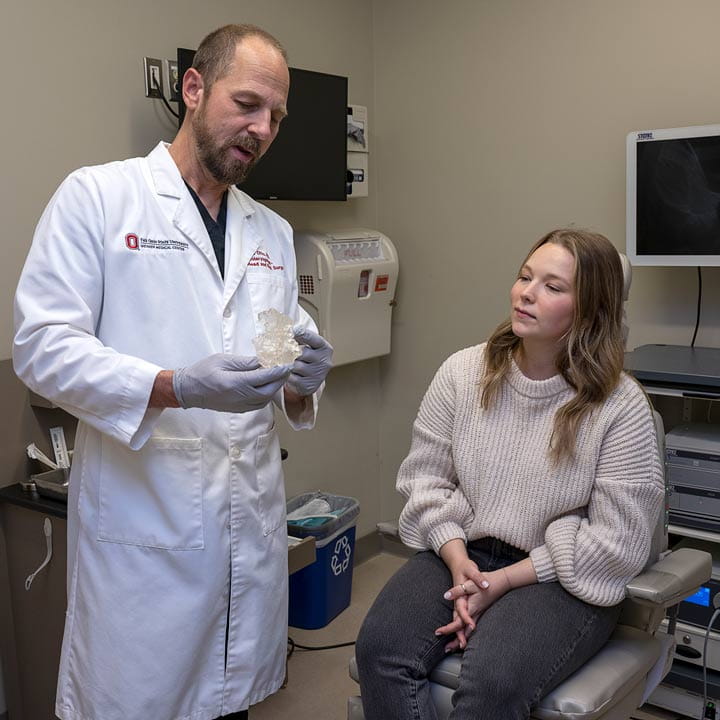 A multidisciplinary research team led by Kai Zhao, PhD, associate professor in the Department of Otolaryngology – Head and Neck Surgery at The Ohio State University College of Medicine, recently received R01 and R13 grants to study chemosensory impacts from COVID-19 and to promote universal chemosensory testing.
A multidisciplinary research team led by Kai Zhao, PhD, associate professor in the Department of Otolaryngology – Head and Neck Surgery at The Ohio State University College of Medicine, recently received R01 and R13 grants to study chemosensory impacts from COVID-19 and to promote universal chemosensory testing.
The COVID-19 virus has had a strong, long-term impact on the sense of smell, especially when compared to other viruses. Up to 12% of patients with COVID-19 haven’t gotten back their sense of smell.
“COVID-19 brought the importance of smell disorders to the forefront,” says Bradley Otto, MD, director of the Division of Rhinology and clinical associate professor in the Department of Otolaryngology – Head and Neck Surgery at the Ohio State College of Medicine. “We’re now able to research better therapies and focus research on something that impacts people significantly.”
From a patient care perspective, this research can lead to better predictive prognoses for patients by identifying the key reasons some patients have longer sensory deficiencies after infection. It may also lead to improvements in public health, including adjusting policies, treatment guidelines and resources for caring for patients.
“Even as the acute phase of the pandemic is over, we are trying to understand the overall impact of COVID-19 on sensory functions, recognize what recovery looks like and identify a surveillance system to catch potential variants,” Dr. Zhao says. “Overall symptoms seem to be reduced now, but we don’t know what future variants hold. We are doing testing to understand and be prepared for how these variants could affect sensory functions.”
Along with continuing COVID-19 research, Dr. Zhao received an R13 grant as co-principal investigator, along with researchers from three other universities, to promote universal chemosensory testing, which aligns with research into sensory loss from COVID-19 infection.
“Everyone in the U.S. has their eyes examined during their life and every newborn baby gets hearing tests, but we never do chemosensory testing,” Dr. Zhao says. “This pandemic was a reminder that we don’t know much about chemosensory functioning for patients or have an understanding of baselines.”
Dr. Zhao has researched how the complex olfactory structure in animals like cats contributes to their sense of smell and is applying that research to humans to identify options for chemosensory testing and treatment.
Currently, there are very few chemosensory tests available, and those that exist are mostly found within ENT specialties. Dr. Zhao’s research aims to make chemosensory testing accessible for everyone, especially at early stages of life. That way, providers can establish baselines and better recognize congenital smell and taste loss later in life.
As part of a broader, national research effort, Dr. Zhao is part of a research team at the College of Medicine using hard candy as a tool for universal screening.
“Candy is stable, low-tech and accessible almost everywhere,” Dr. Zhao says. “It has a taste and smell component and, being candy, is palatable for young children.”
Moreover, this research may have implications for the early identification of neurodegenerative diseases since loss of sense of smell is a symptom of conditions like Parkinson’s disease and Alzheimer’s disease. Universal screening can also help a lot of people who have sensory alterations and many who don’t realize they have a dysfunction. For example, elderly patients may not have noticed a loss of smell or taste, but this sensory loss can pose a safety issue, such as in smelling smoke or natural gas.
This research can also support patients with nasal obstruction, another area Dr. Zhao has analyzed in the past.
“Dr. Zhao was one of the first researchers to show how humans can sense airflow in their nose and what makes them feel like they are breathing well or poorly,” Dr. Otto says. “We’re taking it to the next level now and figuring out what it is about certain people’s noses that makes them comfortable or not when it comes to nasal obstruction – and how we can resolve any discomfort with surgery.”
As a tertiary referral center, The Ohio State University Wexner Medical Center offers a unique site to perform this critical chemosensory research.
“We benefit from having a multispecialty department and a multidisciplinary research team, as well as a lab on the same floor as our clinic,” Dr. Zhao says. “Our research and clinical teams are very well integrated. Moreover, Ohio State has a large patient base to recruit from for research.”
